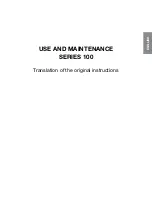
18
19
4
Adjustments
4.1
Measuring and Adjusting the Winding Torques
The rewinder for the transfer ribbon and the internal rewinder are coupled to slipping clutches in the main drive. The
supply hub of the transfer ribbon is braked with a slipping clutch during printing.
The correct setting of the torques of these slipping clutches is necessary for:
precise conveyance of the transfer ribbon during label transport
the prevention of wrinkles in the feed path of the transfer ribbon
sufficiently tight peel-off tension of the liner and thus easy peeling off of labels in peel-off mode
a sufficiently tightened label strip
The winding axes of the rewinder are not actively driven by the belts during label backfeed, but rather solely by the
pull of the print roller. The torque required to disengage the rewinder from the belt drive is implemented via a brake
in the winding reel, which works in both directions. The measured clockwise torque is the sum of the coupling torque
and the torque of the brake. Only the torque of the brake is measured when the winding axis is rotating counter-
clockwise. For this reason, measurement of the torques at the rewinders are required in both directions.
The method of measurement differs for the various types of slipping clutches:
measurement of the winding torques at the transfer ribbon take up and supply hub
measurement of the winding torque at the internal rewinder
page 19.
If the winding torque differs from the set value, it must be adjusted. The procedures for adjusting the winding torques
of the transfer ribbon winders and the internal rewinder are identical
4.1.2 on page 20.
4.1.1
Measuring the Winding Torques
Transfer ribbon take up and supply hub
Measurement of the winding torque at the transfer ribbon take up and supply hub occurs by determining the pulling
forces on a test collar attached to the winder.
The physical relation between the torque and the pulling force is:
F= M / r
F:
Pulling force [N],
M:
Winding torque [Ncm],
r:
Radius of the test collar (30 mm)
•
•
•
•
•
•
















































